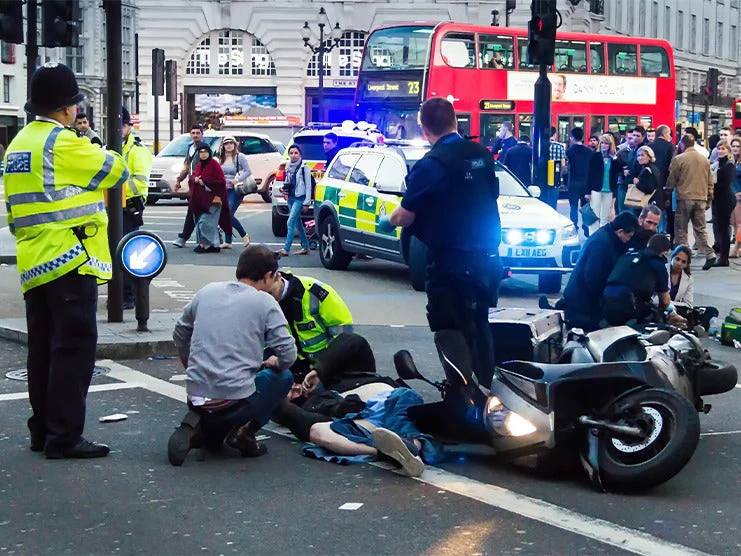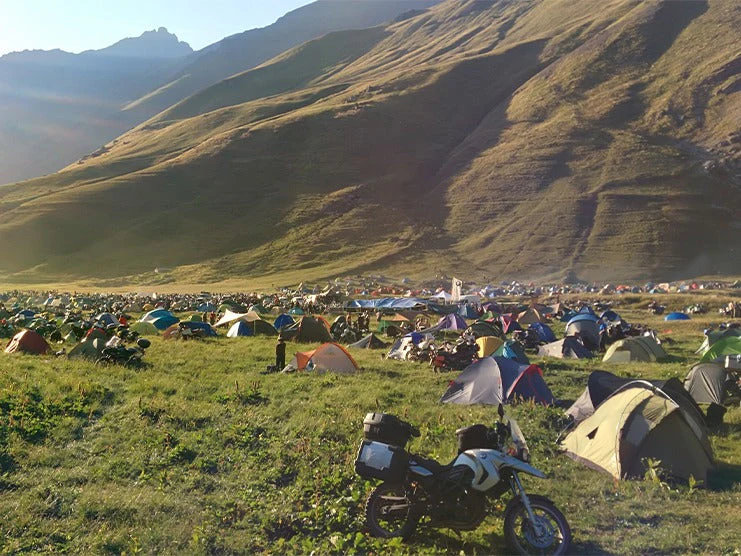With heavier traffic and fewer experienced riders on the road, motorcycle accidents have become more common. More crashes involve motorcycles than cars. This is because they do not come with a collision avoidance system and seatbelts. It is better to avoid speeding and risky maneuvers that could result in injury. To be safe on the road, riders should follow all traffic laws, get a motorcycle license, take riding classes, and wear appropriate riding gear. Though you cannot always avoid motorcycle crashes when on the road, taking precautionary safety measures can reduce the risk. Even if the chances of getting into an accident are low, it is best to know how to be prepared and act in case of a motorcycle accident. This article discusses what to do in case of, during, and after a motorcycle accident.
Table of Content
1. What to Do in Case of a Motorcycle Accident?
1.1 Wearing Riding Gear and Abiding by Traffic Laws

All motorcycle riders should follow all traffic laws and safety guidelines to ensure safer riding. Wearing a helmet, gloves, knee pads, and appropriate riding gear can help prevent severe injuries to the head, brain, and spine. Motorcycle riding gear is designed to absorb impacts during crashes. The likelihood of fatal injuries due to a motorcycle crash increases if you are riding without a helmet.
Following traffic laws, riding below or at the speed limit, and staying alert at all times help reduce the chances of getting into an accident.
1.2 Licensing and Training

If you do not have a motorcycle license, you can get in trouble for illegally riding a motorcycle without credentials following an accident. To earn a motorcycle license, you need to pass several tests that evaluate your riding skills, knowledge of traffic laws, and ability to safely operate a motorcycle. These tests include a knowledge exam, vision screening, and a riding test.
You should also enroll in riding classes, safety courses, and a motorcycle safety awareness program. They will teach you how to deal with road accidents and practice better safety on the road.
1.3 Have Your Emergency Contacts, Documents, and Identification
Make sure to carry all the important documents on your ride, including your motorcycle registration, license, motorcycle insurance, and health insurance cards. Also, carry a card with a list of emergency contacts on it so emergency personnel can contact them.
1.4 Insurance
Most motorcycle insurance policies only cover damage to your motorcycle. Depending on the insurance plan you get, there could be additional financial protection for personal injury, medical bills, damage due to theft, etc. Always make sure you find the right life insurance, along with motorcycle insurance in case something happens to you after a motorcycle accident.
1.5 Motorcycle Laws
Motorcycle safety awareness programs and riding skills tests provide basic knowledge of general traffic laws. However, most states have different motorcycle laws, restrictions, and guidelines. Knowing a state’s motorcycle laws is crucial to prevent collisions and ensuring you do not get in trouble with the law. The rider responsible for a motorcycle crash due to breaking the law or doing something illegal is liable to pay for damages.
2. What to Do During a Motorcycle Accident?

If you are about to crash on your motorcycle, there are measures you can take to avoid severe injuries. Do not panic and suddenly swerve to try to get out of the way. If you think you are about to crash, gradually reduce your motorcycle’s speed by releasing the throttle and gently applying the brakes. Try to point the front of your motorcycle towards a safe spot where you can crash with less risk of severe injuries. Let go of the handlebars and prepare to tuck and roll when you are launched from your motorcycle. Do not hang on to the handlebars or you risk being crushed. After landing, try to put distance between you and the motorbike as it can catch fire due to leaking fuel.
When launched, protect your face by shielding it with your arms. Try to fall on your back and stay low to the ground. To avoid injuring your head, neck, face, and spinal cord, do not put pressure on them. Also, when you are on the ground, do not attempt to get up until you are sure that there are no fractures or injuries. You might also have a concussion, so make sure to not move abruptly to avoid permanent brain damage.
Also Read: 10 MOST COMMON MOTORCYCLE ACCIDENT INJURIES
3. What Should You Do After a Motorcycle Accident?
3.1 Check for injuries
Immediately following an accident, check yourself for injuries to see if you require urgent medical assistance. After checking yourself and getting up if you can, look around to see if someone else has been injured and requires help. If you find an injured rider, make sure he/she is away from the crashed motorcycle as it can explode at any moment due to fuel leakage. If you have to move the injured rider, make sure to support his/her head, spine, and neck to avoid traumatic brain injury or paralysis. If you do not know how to provide emergency assistance, call an ambulance to your location.
3.2 What Not to Do
Do not speak with anyone about the accident, not even the police. Also, do not admit your fault or apologize to anybody. Even if someone comes to you to get your account, tell them that you have to get medical assistance first.
3.3 Collect Evidence
Take pictures and record videos of the accident site and the damaged motorcycles immediately after an accident. If you are injured and are unable to take pictures, call your family members or friends to come and collect evidence for you.
3.4 Talk to Witnesses
If possible, talk to witnesses and collect information about the accident. Get their contact information in case you need to get in touch with them later. A witness is a neutral party whose testimony can play a crucial role when it comes to negotiating with insurance companies.
3.5 Hire a Motorcycle Accident Lawyer
It is best to immediately get in touch with your insurance company. If your motorcycle is your only mode of transportation, you will want to be fully compensated for the damaged motorcycle.
Motorcycles do not retain their original values, especially when ridden for several hundred miles. However, your insurance company will pay you the motorcycle’s current value in the market if your ride was damaged in an accident. To negotiate with the insurance company, it is best to hire a motorcycle accident lawyer. Rather than talking to the police or other people, talk to a motorcycle accident lawyer about the accident. They can help you settle the matter with the insurance company and ensure you receive adequate compensation.
4. Takeaway
If you are a motorcycle enthusiast, you should know how to deal with emergency situations like motorcycle accidents. Motorcycles are big investments, but they are not worth more than your life. It is recommended you buy quality riding gear to ensure your safety. Make sure to choose the right insurance and hire a motorcycle safety lawyer to help negotiate with your insurance company.
Always follow traffic laws, avoid speeding, and avoid getting distracted while riding. In case you get involved in an accident, always be prepared. First, check yourself to make sure you are not injured. If you are not injured, get up and check to see if anyone else got injured. Enroll in safety classes and motorcycle safety awareness programs to learn how to properly help injured riders.
Just like how riding gear can help keep you safe from injuries, it is important you protect your motorcycle. Aftermarket parts, including crash bars (engine guards, and frame guards), fairings, and sissy bars, improve aesthetics and safety. The luggage options available at Viking Bags, including saddlebags and sissy bar bags, can help carry first-aid kits and store motorcycle gear. You can also find handlebars on Viking Bags online store to improve overall comfort.












Leave a comment
All comments are moderated before being published.
This site is protected by hCaptcha and the hCaptcha Privacy Policy and Terms of Service apply.